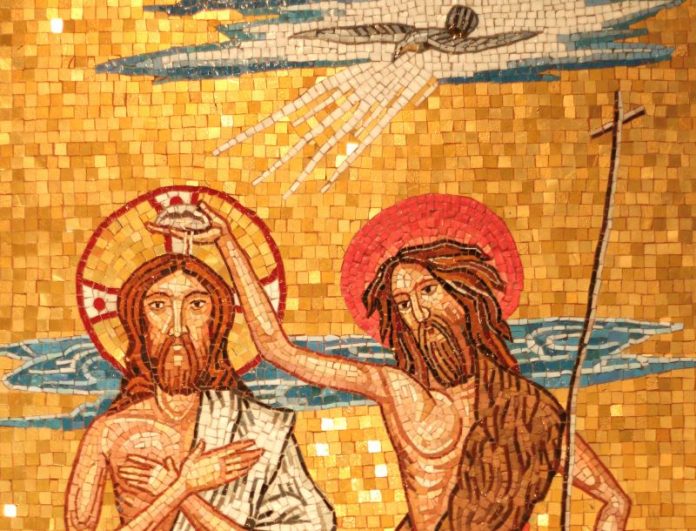
Lesson ideas and tips
WILLIAM O’LEARY
Experience isn’t the best teacher when it comes to teaching Baptism to children and young people (and most adults). How can you help those you are catechizing understand the importance of Baptism when they can’t even remember the day? This article will provide ideas on what and how to catechize about Baptism, enhancing its meaning and value to children.
Three key realities ought to be at the center of our catechesis of Baptism, undergirding all that we teach about this sacrament.
1. Baptism makes us children of God — adopted sons and daughters of God.
2. Baptism washes away original sin, frees us from the power of darkness, and makes us children of the light. We become new creations who are born again through the waters of Baptism and the Holy Spirit.
3. Baptism brings us into God’s family, the Church, where we become members and partakers of the divine life of God through his gift of grace.
How can we teach children about the most precious of gifts that identifies all who have received it as belonging to Jesus Christ? Regardless of the age group, the more we can teach by using concrete objects and symbols, the more engaging and memorable will our catechesis on Baptism be. Consider the following points by age groupings when catechizing:
Kindergarten through third grade
(Most of this material will work with these grades; although there is a lot of text, note that your participants should be doing some moving and not merely sitting still — especially if you can go to the church for instruction.)
■ Note the Scriptural basis for Baptism: Matthew 28:19-20; Mark 16:16; Acts 2:38; Acts 22:16.
■ Share that, at Baptism, God’s special light comes into our lives, and we become children of God. This is one of the most special days of our lives. Ask students what their parents have told them about their Baptism.
■ Tell the story of how a long time ago God’s people lived in darkness because of sin in the world (see Isaiah 9:2).
■ If you are in church, show them the baptismal font. If you are not in church, show them a picture.
■ If possible, show them the paschal candle (if in a classroom, bring a smaller version of the paschal candle (or a picture of it) to allow the children to see and even hold it.
■ Tell them about the paschal candle and how it was lit on Easter. This light reminds us of Jesus.
■ Point out and explain the symbols that are on the paschal candle: alpha, omega, cross, number for the current year. You will find a great visual explanation at CATmag.us/2Xu2klA that you can download and print.
■ Share the other important items used at Baptism — the white garment, the baptismal candle, the sacred oils of catechumens, and the oil of chrism. Perhaps you can get a priest or deacon to show you the oils in the church, where the children can smell the oils. If not, you can show them a picture. Go to CATmag.us/2WfsRS6 for a visual depiction.
■ Ask them: “What does water remind us of?”
■ Illustrate the following first, and then have each of your students imitate you individually. Have each child take his or her left fist (symbolizing their heads when they were babies), and over a large bowl, let them say their name and the words of Baptism. Instruct them to pour the water over their fists with their right hand. “N___, I baptize you in the name of the Father and of the Son and of the Holy Spirit.”
■ Tell them God has called each of us by name. Remind them of the importance of the first time that the priest, deacon or bishop said their name, at Baptism.
■ Share with them that at the moment they were baptized, they became different. God came very close to them, making them new creatures in Christ and a light to the whole world.
■ Explain the following:
♦ Baptism oils There are two oils used at Baptism (at a minimum have a picture). Share:
◗ The oil of catechumens was applied before you were baptized. The Sign of the Cross was made on your chest by the priest or deacon. It is a sign of strength and protection.
◗ The second oil, the oil of chrism, is used by the priest after you were baptized. This perfumed oil is a sign of gladness, thanksgiving, and celebration.
◗ The oils tell us about what the Holy Spirit does in our life. His grace strengthens and protects us and brings us joy and gladness. Communicate: This happens at our Baptism, but also every day as we remember that wonderful moment of becoming part of God’s family!
♦ Water
◗ What is water used for? It is absolutely necessary to sustain life for all living things — animals, plants, and us.
◗ It is a sign of new life and becoming clean.
♦ Baptismal font
◗ Ask: At our church, where is the baptismal font? Communicate: Fonts come in all different sizes — some look like a little dome which symbolizes a womb (like when a mom is pregnant). Out of that womb comes new life. Others are larger in the form of a cross or tomb into which one goes down and comes back up — rising to new life.
♦ Special gesture over the water
◗ The priest or deacon prays over the water before a baby is baptized.
◗ The Holy Spirit comes over the water, and soon that water is poured over a baby’s head.
♦ White garment
◗ It symbolizes purity — we put on Christ as a new creation.
◗ It helps us to understand that what appears on the outside is what has happened on the inside.
♦ Candle
◗ At your Baptism, you were given a candle lit from the paschal candle.
◗ This symbolizes that you are the light of the world.
■ Conclude by having them renew their Baptismal Promises. See CATmag.us/2IhLwI8 to find a copy of them.
Other tips/aids for this age group:
■ Show part or all of the DVD Born into the Kingdom from BrotherFrancis.com.
■ Some valuable worksheets can be found at TeachersPayTeachers.com or CATmag.us/317X6xP.
Fourth to sixth grades
Remember to allow Scripture to be the driving force of your lesson: Matthew 28:19-20; Mark 16:16; Acts 2:38; Acts 22:16.
Do you ever use the rites themselves to catechize? The Catechism of the Catholic Church puts it beautifully when it says in paragraph 1074:
The liturgy is the summit toward which the activity of the Church is directed; it is also the font from which all her power flows.” It is therefore the privileged place for catechizing the People of God. “Catechesis is intrinsically linked with the whole of liturgical and sacramental activity, for it is in the sacraments, especially in the Eucharist, that Christ Jesus works in fullness for the transformation of men.” [Catechesi Tradendae, 23]
Use the Rite of Baptism (found here: CATmag.us/2QMWGs7) to catechize about Baptism.
■ Using the Rite is a great way to show young people the gift of Baptism and its importance. It’s a very valuable and engaging way to talk about Baptism.
■ Consider giving roles to different students and doing a “mock Baptism.”
■ Follow-up questions:
♦ Share what the priest asks of parents.
♦ Ask: Do you know that your parents made a commitment to raise you as a faith-filled Catholic throughout your life? The priest told them: “You have asked to have your child baptized. In doing so you are accepting the responsibility of training him (her) in the practice of the faith. It will be your duty to bring him (her) up to keep God’s commandments as Christ taught us, by loving God and our neighbor. Do you clearly understand what you are undertaking?”
◗ Discuss these two responsibilities of parents:
◊ To train you in the practice of the faith.
◊ To help you keep God’s commandments as Christ taught us by loving God and neighbor.
◗ Share: Your godparents also were asked if they were willing to accept the duty and responsibility of helping your parents raise you in the faith.
♦ Share: The priest says these amazing words in the name of the Christian community: “I claim you for Christ, our Saving Lord, by the sign of the cross” (which is then traced on your forehead by the priest and then by your parents and godparents).
◗ What does it mean to be claimed for Christ?
◗ Emphasize how important the Sign of the Cross is and how the priest, your parents, and godparents claimed you for Christ by this sign.
♦ Then each of us is baptized in the name of the Father, Son, and the Holy Spirit. Our lives have not been the same since.
♦ Conclude by talking about the meaning of the sacred oils, the baptismal garment, and the candle.
Other possible resources:
■ Baptism videos: CATmag.us/2KsIrra or CATmag.us/2IjrEUO
■ Explanation of the paschal candle and its importance: CATmag.us/2Xu2klA or
CATmag.us/2wCz9AU
Some ideas for seventh to twelfth grades
■ Baptism is the door to the spiritual life. A short video by Bishop Barron is shared here:
CATmag.us/2HYSwL7.
■ At CATmag.us/2HWeCxC Busted Halo has a video about Baptism.
■ Share how Baptism imprints an indelible mark upon the soul. Emphasize how this invisible reality speaks of the truth that we belong to Christ and our identity as followers of Christ is in him.
■ It is useful for this age group to talk about the Rite of Baptism (see above).
■ Visit CATmag.us/2XmzfII for a question-and-answer video on infant Baptism.
Baptism is a Sacrament of Initiation. It is — hopefully! — the beginning of our long and fruitful journey as disciples of Jesus Christ. Since most of us were infants when we were baptized, we may not have learned the important signs and symbols by which the sacrament works in us. This is the most important reason for instructions about the purpose, effects, and value of this sacrament.
William O’Leary lives in Kansas with his wife and three children. He is the Director of Religious Formation for a large parish in Overland Park, Kansas. Over the last 20 years, his work in pastoral ministry has explored ways to draw parents and their children into the practice of their faith. His blog is RelevantCatechesis.com
This article was originally published in Catechist magazine, September 2019
Photo: Fr. Lawrence Lew, O.P.




